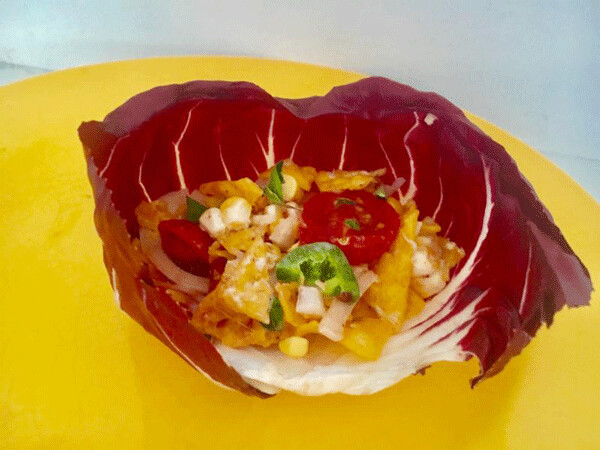News & Articles
Browse all content by date.

Sugar is increasingly viewed by the public to be toxic in amounts that most Americans regularly consume, and many people are making efforts to curb their intake. But even as we shun junk food and other sources of sweetness, sugary snacks that are whole plant parts, like fruit and real baby carrots, get a pass.
Sweet carrots, at least, have fiber, and a hint of earthiness to go with that sweetness. A good piece of fruit, meanwhile, will be tart, which balances the sweet. But no fresh vegetable is so blindly praised for sweetness, and sweetness alone, as fresh sweet corn. As the name implies, and to the exclusion of almost any other flavor metric, sugar content is what determines quality in sweet corn.
As you may have guessed, I’m not a huge fan of the buttered cob, although I don’t fault anyone else. I appreciate the primal act of gnawing kernels from a seed head, but I prefer to get my daily sugar/fat in other ways. But every dish can generally stand at least a touch of sweetness, and sometimes sweet corn is a great way to add it. Compared to plain sugar, sweet corn is actually kinda interesting. It supposedly contains a hint of umami, and it does have a pleasant grassy flavor, like when you chew on a tender piece of grass.
Being a grass, an ear of sweet corn straddles the line between vegetable and grain, and has roughly the same amount of sugar as an apple. But this seasonal treat is a niche crop compared to its cousin field corn, which has less sugar and is dried before use, like a typical grain. Field corn is also America’s most planted crop, and is tied with potatoes for the distinction of being the crop that delivers the most calories per acre--15,000--according to Washington Post columnist and field corn enthusiast Tamar Haspel.
But unlike potatoes, field corn can be dried and stored for years. It can be ground into masa for tortillas, or into polenta, or made into corn bread, corn meal porridge, and other such corn-based dishes, that feed billions of people around the world. In the U.S., unfortunately, high fructose corn syrup is the preferred corn-based dietary staple, but this misuse is hardly a reflection on the crop itself. If anything, it underscores the ability of corn to harvest solar energy, as does the questionable pursuit of ethanol-based gas for our cars, or the debatable practice of feeding corn to delicious animals.
The reasons behind corn’s amazing capacity to convert carbon dioxide to sugar are multiple. The grass family is one of the world’s most advanced forms of plant life, and about half of all grasses --corn included--have a special metabolic pathway called C4, which allows the plant to more efficiently use both carbon dioxide and water, making it more drought-resistant and tolerant of climate change. Corn is extremely malleable genetically, making it easy to breed into colorful and interesting heirloom varieties, like the 16-foot tall Peruvian field corn I once grew in my back yard from monster-sized kernels. I had to tie it down like a radio tower so it wouldn’t get blown down by summer thunderstorms. More recently, a similarly supersized field corn from Oaxaca was shown to have self-fertilizing activity, like a legume.
Given that Mexico is the birthplace of corn, it’s no surprise to me that Mexican ways of using corn are the best. Tortillas and their derivative chips are the most common, but posole, atole, and chicos, among other field corn-based delicacies, are enjoyed as well--not to mention corn smut, a delicious fungus that infects corn. Mexicans eat sweet corn too, on occasion, but as Haspel notes, field corn is where most of the action is.
If I am going to eat sweet corn, I prefer to add it to dishes that will benefit from that sweetness. I will leave you with one such recipe, which I call Migas Pie, in which both field corn and sweet corn are included. This recipe is a riff on the popular Native American dish, Frito Pie, in which corn chips are tossed with otter ingredients to form a salad. My recipe employs the crumbs from the bottom of the corn chip bag, also known as Migas. They are tossed with a medley of seasonal veggies including sweet corn, tomatoes, jalapeños and onions, as well as hot sauce and mayo, and wrapped into leaves --the more bitter, the better, like radicchio, endive or escarole.
This delicacy includes all of the known official flavors of salt, sweet, acidic, bitter and umami, as well as the aspiring flavors of fat and spice, and a range of crunchy textures. It’s a lively, fun dish to eat and prepare, and can be customized in all sorts of ways. If radicchio is too bitter for you, use lettuce leaves instead.
Migas Pie
One ear sweet corn, kernels sliced
from the cob
One cup migas
One cup cherry tomatoes, each
one sliced in half
1/4 cup minced onion
One teaspoon fresh oregano,
minced
Two tablespoons mayo
Hot sauce to taste
Two teaspoon soy sauce
Two teaspoon vinegar
One tablespoon olive oil
Radicchio leaves (or alternative
foliage), reserved for final step.
Combine all ingredients (except the leaves) in a bowl and mix. Taste, add salt or vinegar as necessary. Spoon into radicchio leaves and eat.
| Tweet |


